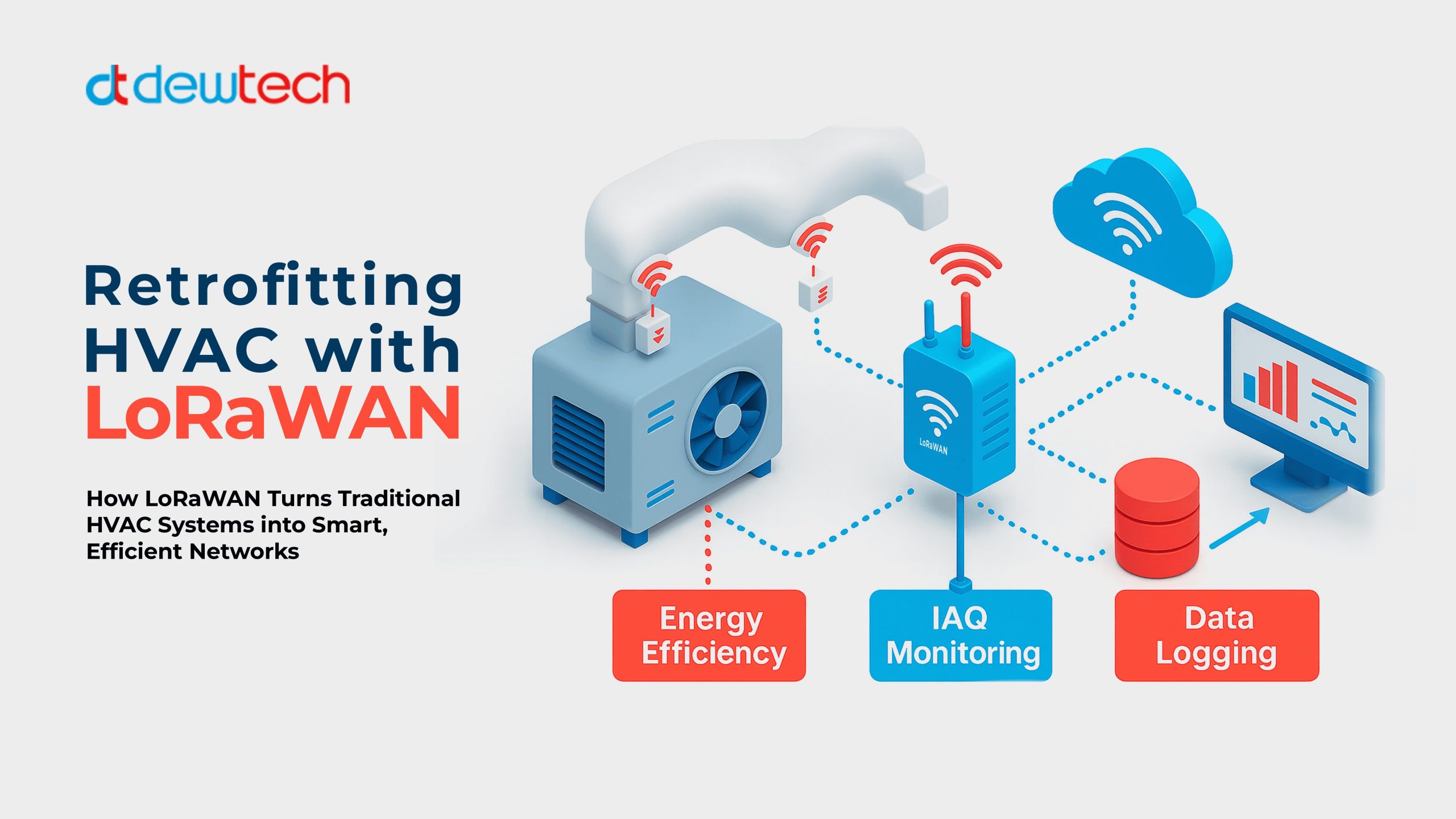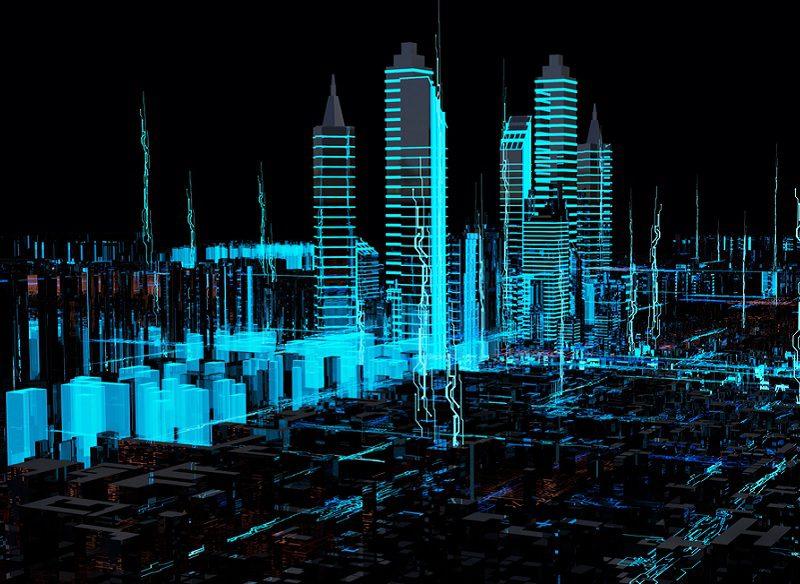Retrofitting HVAC with LoRaWAN: Energy Efficiency, Better IAQ Control, and Reliable Data Logging
Modernizing existing buildings does not have to mean ripping out ducts or rewiring floors. With LoRaWAN HVAC retrofit technology, you can install compact, battery powered LoRaWAN sensors and connect them through a LoRaWAN gateway to your Building Management System (BMS) or cloud in a fast, non disruptive, and cost effective way.
This guide explains how you can use LoRaWAN when retrofitting HVAC systems to achieve three critical outcomes: Greater energy efficiency, Better indoor air quality (IAQ), and Reliable data logging for performance and compliance.
LoRaWAN HVAC retrofit technology enables existing HVAC systems to be modernized without rewiring or disrupting building operations. Wireless LoRaWAN IoT sensors capture real-time data such as temperature, humidity, CO₂, and differential pressure.
A LoRaWAN gateway links these sensors to your Building Management System (BMS) or cloud dashboard. This creates a data-driven environment that improves energy efficiency, indoor air quality, and regulatory compliance.
LoRaWAN transforms traditional HVAC systems into connected, intelligent networks with minimal infrastructure change.
What to Measure
How It Saves Energy
Deployment Pattern: Sensors → LoRaWAN IoT Gateway (Ethernet/4G) → Network Server → BMS or analytics platform. Deploy one or two gateways per block with 30–200 sensors, expanding as needed.
LoRaWAN sensors continuously monitor IAQ parameters critical to occupant comfort and health:
IAQ Control Strategies
IAQ Dashboards and Alerts: All data is visualized within the BMS or cloud dashboard. Real-time alerts notify facility teams when IAQ metrics exceed ASHRAE or WHO limits.
Comprehensive data logging supports IAQ certification, measurement and verification (IPMVP), and sustainability documentation.
Examples of retrofit deployments:
Q1. How does LoRaWAN compare to NB-IoT? LoRaWAN uses unlicensed spectrum and supports private networks with extended battery life. NB-IoT runs on cellular networks, ideal for national coverage but with higher SIM-based costs.
Q2. Does LoRaWAN interfere with Wi-Fi or BAS? No. It operates on a separate frequency with low-duty cycles, ensuring no interference.
Q3. Can LoRaWAN control HVAC equipment directly? Yes. LoRa relays or setpoint commands can control non-critical equipment, while safety-critical systems should remain wired.
Q4. How does Milesight fit into a LoRaWAN HVAC retrofit? Milesight offers complete retrofit solutions including:
This ecosystem simplifies deployment, improves air quality tracking, and enhances overall HVAC energy performance.
If your goal is to cut HVAC energy, maintain healthy air quality, and achieve data transparency, LoRaWAN HVAC retrofit is your fastest route to modernization.
Start with a pilot zone (20–50 sensors, 1 gateway), monitor IAQ and energy KPIs, and scale floor by floor. Within weeks, you’ll gain actionable insights, measurable savings, and a compliant, connected building. Still need professional advice, contact Dew Tech
This guide explains how you can use LoRaWAN when retrofitting HVAC systems to achieve three critical outcomes: Greater energy efficiency, Better indoor air quality (IAQ), and Reliable data logging for performance and compliance.
1. What Is LoRaWAN and How It Modernizes Your HVAC Retrofit
LoRaWAN HVAC retrofit technology enables existing HVAC systems to be modernized without rewiring or disrupting building operations. Wireless LoRaWAN IoT sensors capture real-time data such as temperature, humidity, CO₂, and differential pressure.
A LoRaWAN gateway links these sensors to your Building Management System (BMS) or cloud dashboard. This creates a data-driven environment that improves energy efficiency, indoor air quality, and regulatory compliance.
2. Why Choose LoRaWAN for Retrofitting
- Long range, low power: Provides wide-area coverage with 3–10+ years of battery life.
- No new cabling: Peel-and-stick installation suitable for occupied buildings.
- Vendor-neutral ecosystem: Supports sensors for CO₂, PM2.5, VOC, temperature, humidity, pressure, and energy.
- Seamless integration: Works with BMS over MQTT, HTTP, or OPC.
- Scalable and cost-effective: Begin with a small pilot, then expand across multiple floors or sites.
LoRaWAN transforms traditional HVAC systems into connected, intelligent networks with minimal infrastructure change.
3. Energy Efficiency: Measurable Wins with LoRaWAN
What to Measure
- Zone and return air temperature and humidity
- CO₂ for occupancy-based ventilation
- People Sensor at Office entrance
- Duct static pressure
- Filter differential pressure
- Chilled and hot water supply and return flow
- Energy use across AHUs, FCUs, fans, and pumps
How It Saves Energy
- Demand-Controlled Ventilation (DCV): Adjust outdoor air based on CO₂ levels.
- Static Pressure Reset: Optimize fan speed using duct pressure readings.
- People count data based VAV real time control
- Economizer Optimization: Trigger free cooling using outdoor and return air data.
- Condition-Based Maintenance: Replace filters when differential pressure indicates blockage.
- Chilled-Water Efficiency: Track ΔT to reduce over-pumping and energy waste.
Deployment Pattern: Sensors → LoRaWAN IoT Gateway (Ethernet/4G) → Network Server → BMS or analytics platform. Deploy one or two gateways per block with 30–200 sensors, expanding as needed.
4. Improving Indoor Air Quality (IAQ)
LoRaWAN sensors continuously monitor IAQ parameters critical to occupant comfort and health:
- CO₂ (800–1,000 ppm for optimal ventilation)
- PM2.5 and PM10 (air filtration performance)
- TVOC (odor and chemical exposure tracking)
- Temperature and humidity (comfort and mold prevention)
- Differential pressure (airflow balance in clinics, kitchens, labs)
IAQ Control Strategies
- Increase outdoor air volume when CO₂ or VOC thresholds are exceeded.
- Use filter pressure data to trigger maintenance alerts.
- Maintain pressurization through LoRaWAN-based pressure monitoring.
IAQ Dashboards and Alerts: All data is visualized within the BMS or cloud dashboard. Real-time alerts notify facility teams when IAQ metrics exceed ASHRAE or WHO limits.
5. Reliable Data Logging and Compliance
- Record readings every 1–5 minutes for key IAQ and energy parameters.
- Use edge buffering to prevent data loss during network downtime.
- Generate tamper-proof logs for compliance and audit tracking.
- Integrate with analytics in Niagara or similar platforms
Comprehensive data logging supports IAQ certification, measurement and verification (IPMVP), and sustainability documentation.
6. LoRaWAN HVAC Retrofit Examples
Examples of retrofit deployments:
- Office Tower DCV: CO₂/T/RH sensors and 1 gateway per 10–15 floors – 12–25% fan and chiller energy reduction.
- Office Tower: People count based VAV control in Muti Zone multiple Buildings
- Mall AHU Optimization: Duct static and filter ΔP sensors – 5–15% fan energy savings.
- Clinic Pressurization: Differential pressure sensors – Automated compliance reports.
- Residential Building: Holiday/Vacant rooms temperature Scheduling. Temperature setpoint schedule
7. Planning and Deployment Tips
- Site Survey: Review plant rooms, basements, and risers for optimal gateway placement.
- Data Frequency: 2–5 minutes for IAQ, 1 minute for ΔP, 10–15 minutes for energy meters.
- Battery Optimization: Balance reporting intervals to extend device life.
- Integration: Use MQTT JSON payloads mapped to BACnet or OPC.
- Governance: Define alert thresholds and assign notification roles clearly.
8. FAQ
Q1. How does LoRaWAN compare to NB-IoT? LoRaWAN uses unlicensed spectrum and supports private networks with extended battery life. NB-IoT runs on cellular networks, ideal for national coverage but with higher SIM-based costs.
Q2. Does LoRaWAN interfere with Wi-Fi or BAS? No. It operates on a separate frequency with low-duty cycles, ensuring no interference.
Q3. Can LoRaWAN control HVAC equipment directly? Yes. LoRa relays or setpoint commands can control non-critical equipment, while safety-critical systems should remain wired.
Q4. How does Milesight fit into a LoRaWAN HVAC retrofit? Milesight offers complete retrofit solutions including:
- AM Series IAQ Panels: CO₂, PM2.5/PM10, TVOC, temperature, humidity.
- EM500 Series Sensors: Differential pressure, temperature, and flow.
- UG65/UG67 Gateways: Reliable BMS connectivity via MQTT or HTTP.
This ecosystem simplifies deployment, improves air quality tracking, and enhances overall HVAC energy performance.
9. Conclusion and Next Steps
If your goal is to cut HVAC energy, maintain healthy air quality, and achieve data transparency, LoRaWAN HVAC retrofit is your fastest route to modernization.
Start with a pilot zone (20–50 sensors, 1 gateway), monitor IAQ and energy KPIs, and scale floor by floor. Within weeks, you’ll gain actionable insights, measurable savings, and a compliant, connected building. Still need professional advice, contact Dew Tech
Share
Don?t Have An Account?
Have An Account?

